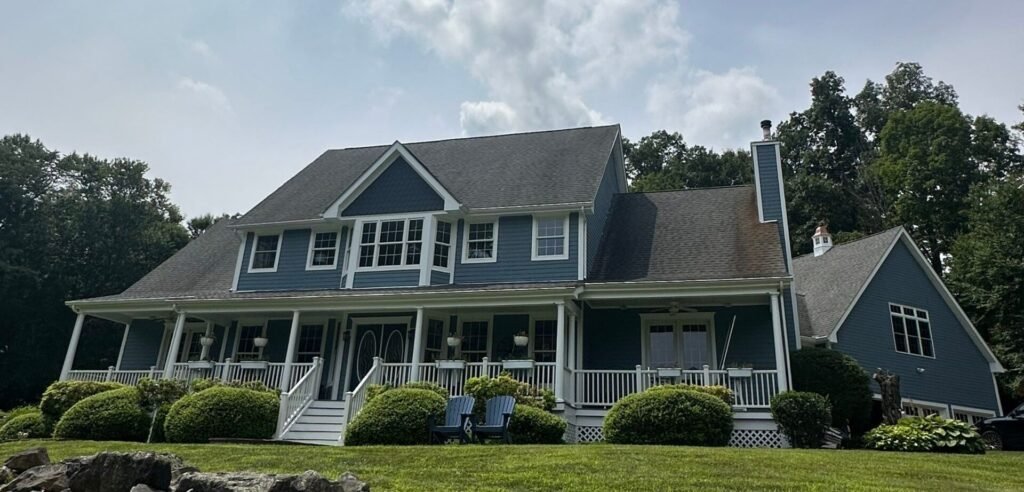Your home’s exterior paint is its first line of defense against the elements and its primary curb appeal enhancer. Knowing how often to repaint is crucial for protecting your investment, maintaining aesthetics, and avoiding costly repairs down the line. The answer isn’t a fixed number; it depends on several key factors.

Average repaint intervals by material
Different siding materials have varying paint lifespans due to their inherent properties and how they interact with paint.
Wood siding: 3–7 years
- Why: Wood is a natural material that expands and contracts significantly with temperature and humidity changes. This movement puts stress on the paint film, leading to cracking, peeling, and chipping. It’s also susceptible to moisture absorption and rot if not properly protected.
- Lifespan: Requires more frequent repainting to maintain protection.
Stucco: 5–6 years
- Why: Stucco is a porous, cement-based material. While durable, it can develop hairline cracks over time due to settling or temperature fluctuations, allowing moisture in. It’s also prone to efflorescence and mold growth in damp climates.
- Lifespan: Regular repainting (with elastomeric or breathable paints) helps seal these cracks and maintain its appearance.
Aluminum: 5 years
- Why: Aluminum siding is stable but can oxidize and develop a chalky residue (“chalking”) over time as its factory finish degrades, especially in sunny climates. Paint adhesion can be an issue if chalking isn’t properly removed.
- Lifespan: Repainting addresses chalking and refreshes color.
Fiber cement: 10–12 years
- Why: Fiber cement (e.g., HardiePlank) is engineered for durability and stability. It’s highly resistant to rot, insects, and cracking due to its composition. Its dimensional stability means less stress on the paint.
- Lifespan: Often has the longest paint lifespan among common siding materials when prepped and painted correctly.
Painted brick: 12–18 years
- Why: Unpainted brick is very low maintenance. Once painted, the paint adheres incredibly well to its porous, stable surface. Brick itself is highly durable and stable.
- Lifespan: Can offer the longest intervals between repaints, provided a breathable, high-quality masonry paint is used.
Weather, quality & prep impact lifespan
Beyond the material, these factors are critical:
- Climate & Weather Exposure:
- UV Radiation: Intense direct sunlight causes paint to fade and break down faster. South and west-facing walls typically need repainting sooner.
- Rain & Humidity: Excessive moisture promotes mold, mildew, and paint failure.
- Temperature Extremes: Frequent freeze-thaw cycles and drastic temperature swings cause materials to expand and contract, stressing the paint.
- Salt Air: Coastal environments are harsh on paint.
- Paint Quality: Investing in premium, high-quality exterior paint (100% acrylic latex or similar) offers superior durability, color retention, and resistance to elements, lasting significantly longer than cheaper alternatives.
- Surface Preparation: This is arguably the most important factor. Thorough cleaning, scraping loose paint, sanding, patching, and proper priming ensure the new paint adheres optimally and lasts its maximum lifespan. Poor prep leads to premature peeling and failure.
- Application Quality: Applying paint in thin, even coats, allowing proper drying time between coats, and painting in ideal weather conditions all contribute to durability.
Interior vs exterior painting cadence
- Exterior: Driven primarily by protection from weather, material degradation, and curb appeal. Typically longer intervals, but more critical for structural integrity.
- Interior: Primarily driven by aesthetics, wear and tear from daily living, and personal preference. Rooms with high traffic (kitchens, hallways) may need repainting every 3-5 years, while low-traffic areas (guest bedrooms) might last 7-10+ years. Interior paint generally doesn’t face the same extreme environmental stressors.
Signs it’s time to repaint
Don’t wait until the paint is visibly failing. Look for these signs:
- Fading: Colors appear dull or washed out.
- Chalking: A powdery residue comes off when you wipe the surface (common on older aluminum or stucco).
- Cracking/Alligatoring: Paint develops a pattern of fine cracks, resembling alligator skin.
- Peeling/Flaking: Paint separates from the surface in chips or sheets.
- Bubbling/Blistering: Small pockets of air or moisture trapped under the paint.
- Mildew/Mold: Persistent dark spots that cleaning can’t remove.
- Exposed Substrate: Bare wood or siding is visible, indicating a complete loss of protection.
Maintenance between paint jobs
- Regular Cleaning: Annually or bi-annually, gently wash your home’s exterior to remove dirt, dust, pollen, and mildew. This prevents buildup that can accelerate paint degradation.
- Address Minor Issues: Promptly repair any small cracks, chips, or areas of peeling. Spot-prime and touch up these areas to prevent larger problems.
- Trim & Caulk Inspection: Check caulking around windows, doors, and seams. Re-caulk any cracked or missing areas to prevent water intrusion.
- Gutter Maintenance: Keep gutters clean to ensure proper drainage and prevent water from spilling onto siding.
Budget planning for repainting
- Long-Term Investment: View exterior painting as a vital protective measure for your home’s structure and an investment in its value.
- Future Planning: Factor exterior painting into your long-term home maintenance budget. Knowing average lifespans for your specific siding helps you plan.
- Get Quotes: Obtain multiple quotes from reputable painting contractors to understand current costs and ensure proper surface preparation.
Genesis Pro Painting specializes in high-quality exterior painting that protects and enhances your home for years. We understand the nuances of different siding materials and climate impacts, providing expert advice and flawless execution to maximize your paint’s lifespan and curb appeal.
